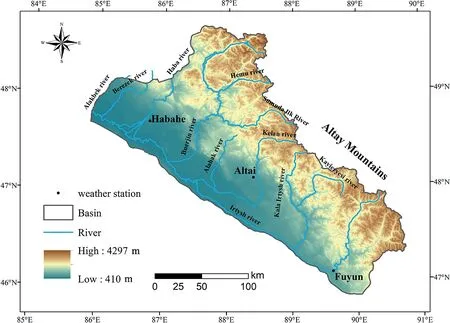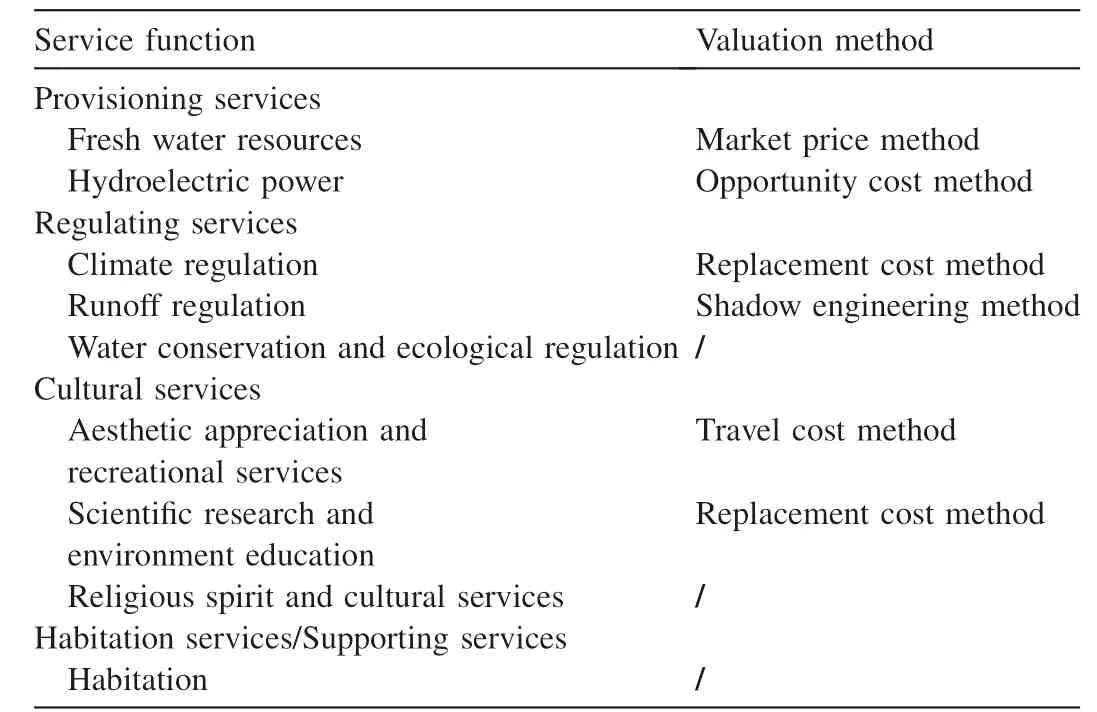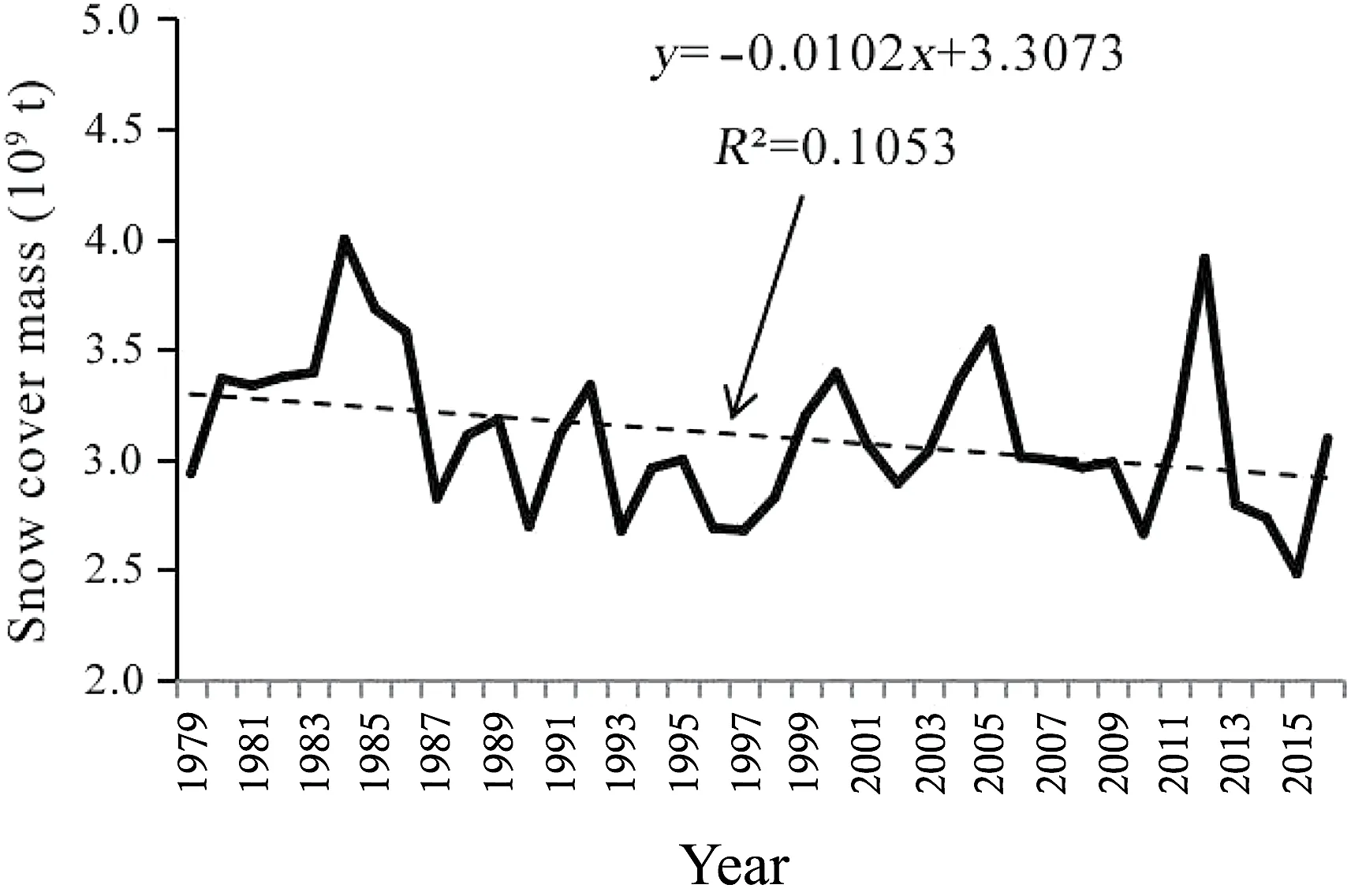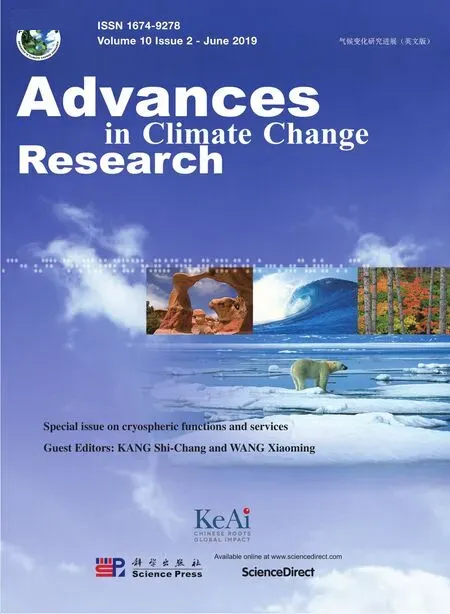Valuating service loss of snow cover in Irtysh River Basin
2019-08-13YANGYngWUXueJioLIUShiWeiXIAOCunDeWANGXioming
YANG Yng, WU Xue-Jio, LIU Shi-Wei, XIAO Cun-De, WANG Xioming,*
a State Key Laboratory of Cryospheric Science, Northwest Institute of Eco-Environment and Resources, Chinese Academy of Sciences, Lanzhou, 730000, China
b College of Resources and Environment, University of Chinese, Academy of Sciences, Beijing, 100049, China
c State Key Laboratory of Earth Surface Processes and Resources Ecology, Beijing Normal University, Beijing, 100875, China
Abstract Snow cover provides essential resources and services for human well-being and socioeconomic development in arid areas.With the change in snow cover resulting from climate change that causes concerns about its consequences, there is a pressing need to analyze and understand its impact on the benefits that people has been enjoying from snow cover. These can be derived from the variation in economic value of snow services, that are demanded to meet socioeconomic activities. Based on the average decline mass of snow cover from 1979 to 2016 in Irtysh River Basin, we use the approach by applying economic evaluation to estimate the annual value loss of snow services. Considering the decreasing trend of snow cover mass at rates of-10.2 Mt per year(p <0.05)or 0.3%per year,the annual service loss in Irtysh River Basin is currently worth up to CN¥196 million.Within it,the service loss of climate regulation contributes the most,or about CN¥84.7 million.The loss of freshwater service contributes only about 19%,implying that there would be a significant underestimation of service loss if only water supply would be considered. This may cause biased decision-making when we are facing the challenges of declining services as a result of climate change, impacting on the balancing of socioeconomic development and environment conservation for the sustainability over a long term.
Keywords: Cryosphere science; Climate change; Snow cover; Cryosphere service; Service value; Irtysh river basin
1. Introduction
The cryosphere refers to the portion of the Earth's surface including mountain glaciers, ice sheets, ice shelves, snow cover,permafrost,and seasonal frozen ground.It is extremely sensitive to climate change. The headwater of many Asia's great rivers in China is located in the cryosphere, which is actively interacting with and influencing on other earth spheres. The cryosphere is an important water resources that critically support economic development of oasis and ensure the stability of its ecosystem in arid regions.
Snow cover, as one of the most significant components in the cryosphere, provides essential resources or services for people's utilization and climate regulation through a water cycle. About one sixth of the world's population (1.2 billion people)relies on snowmelt for agriculture,living consumption and so on (Barnett et al., 2005). Virtually, all of the world's population benefits from the services provided by snow cover,which may include, but not limit to, culture, ecosystems,socio-economy and sustainable development in arid areas.Snow cover also provides an irreplaceable resource for outdoor recreation industry (Burakowski and Magnusson, 2012).
While the snow cover exhibits a large year-to-year variation in its depth and snow water equivalent (SWE) (Brown, 2000;Wang et al.,2010;Sturm et al.,2017),the snow mass shows a declining trend (Kunkel et al., 2016). It is considered as a result of warming climate (Mote et al., 2005). It is also reported that the number and intensity of winter snowfall events appeared decreasing (Lute et al., 2015). In the arid areas that count on the winter snow cover for water supply, the decreasing trend is causing considerable concerns (Yao et al.,2013). The tension between reduced water supply and increased water consumption to meet population growth and economic development is getting even greater(Ding and Xiao,2013; Deng, 2018). Therefore, there is an increasing need to effectively and efficiently manage the decreasing snow cover resources.By doing that, it is necessary to understand what is the service that can be provided by snow cover and its valuation,in particular,its change for better management decisionmaking under such a challenging circumstance.
In fact, there are many studies about the valuation of ecosystem services in relation to such as forest, lake, desert,wetland (Song et al., 2016; Stavi et al., 2016), but there are few to evaluate the services provided by the cryosphere.Recently, Zhang et al. assessed the hydrological regulation service of glaciers in Manas River Basin on the basis of shadow engineering method(Zhang et al.,2009).By applying the glacier inventory data including glacier area and ice reserves of the Tianshan Mountains in China, the service valuation was established (Zhang et al., 2018).
In this study, a typical snow cover region in Northwest China is selected for the valuation of snow service loss,to shed a light on the consequences of the service loss in a monetary term on a much more comprehensive picture. It may also provide additional environmental economic information for decision-makers in better managing cryosphere services to balance economic development, well-being and environment conservation.
2. Study areas
Located in Asia, the Altay Mountains ranges from northwest to southeast, across several countries including Kazakhstan, Russia, China and Mongolia. The study area is the Irtysh River Basin in the Altay Mountains in northern Xinjiang of China (Fig. 1). The drainage area of the basin,calculated using digital elevation model data at high spatial resolution(30×30 m),is 42,934 km2,and the altitude ranges from 410 m to 4297 m above sea level.The Irtysh River has a few tributaries,such as Kara Irtysh River,Kelan river,Buerjin River and Haba River. There are few glaciers on the underlying surface of the Irtysh River Basin. The soil is mainly sandy with shallow soil. The area is relatively rich in vegetation covered by low grass. The forests mainly distribute on the semi-cloudy slope, overlying slope or along the river course. Dominant species are Siberian spruce, Siberian larch,and some poplars that distributed at low altitude(Zhang et al.,2014).
This region is influenced by the westerly wind, and the snow occurs the most across a year,creating a thick and stable winter snow cover. In a continental climate, its winter is long and cold, and summer is warm and hot. Precipitation occurs more in winter and summer, and increases with altitude and decreases from west to east. Annual precipitation is 200-300 mm in low mountainous areas, and more than 600 mm in high mountainous areas.The snowfall is more than rainfall, and the snow cover duration is prolonged with the increase in altitude. The snow cover in the middle mountain lasts as long as 6-8 months,while that in low mountains does only 5-6 months.Temperature decreases with higher altitude.Based on the observation of Fuyun station, a mean annual temperature is 3.0°C and mean annual precipitation is 190 mm. Snowmelt begins in March. The changes in hydrological process caused by climate warming in recent years have affected water supply (Ding and Zhang, 2015), agricultural and livestock production in the lower reaches of the river.
The Irtysh River is the only one in China, running into the Arctic Ocean. In 2016, the Gross Domestic Product (GDP) in Altay region is CN¥21.7 billion, the GDP per capita is CN¥33,900. Altay region is the second largest natural forest area and one of the important livestock production bases.
3. Data and methodology
3.1. Extraction of snow cover mass change
The dataset used is the long-term depth dataset of China,which is the latest version released by Cold and Arid Regions Sciences Data Center at Lanzhou (http://westdc.westgis.ac.cn). It covers the entire land surface of China (15°-55°N,60°W-140°E). A reference spatial resolution of 25 km × 25 km was adopted with daily temporal resolution.The dataset is available from 1979 to 2016.
The inversion method named Chang algorithm has been developed to revise the Snow depth dataset (Che et al., 2008;Dai et al., 2012). This dataset was validated using meteorological observation data, considering the influences from vegetation, wet snow, precipitation, cold desert and frozen ground. Furthermore, the modified algorithm is dynamically adjusted based on the seasonal variation of grain size and snow density (Che et al., 2008). A constant snow density(240 kg m-3) in the study was used to calculate Snow Water Equivalent (SWE). The snow depth products have been extensively validated (Dai et al., 2015) and proved to be appropriate to determine peak accumulation and seasonal SWE cycle.Therefore,this product has been widely utilized in the climatic and hydrological research communities (Li et al.,2008; Zheng et al., 2009; Ji and Kang, 2013; Yuan et al.,2016).

Fig. 1. Map of the Altay Mountains and Irtysh River Basin.
3.2. Valuation of snow cover
In economic analysis, the value of natural resources can be categorized into use value and nonuse value. Use value includes direct use value, indirect use value and optional value. Nonuse value comprises heritage value and existence value.
Referred to the Millennium Ecosystem Assessment Framework and Xiao et al. (2015), cryosphere service is considered as the benefit that the cryosphere provides to human society. Direct use value of the service refers to the value that were provided directly to people by the cryosphere. It includes output value (e.g., freshwater and clean energy) and non-output value with noncompetitive and nonexclusive services (e.g., aesthetics and recreation, scientific research, environmental education, religious, and cultural value). It is more or less related to the services of provisioning and culture, respectively. In contrast, indirect use value refers to the benefits indirectly obtained from the cryosphere (e.g., climate regulation, runoff regulation, water conservation and ecological regulation services). It is more associated with the services of supporting and regulating.Based on the definition, the services can be classified into four categories: provisioning services, regulating services,culture services, and habitation or supporting services(Table 1).
Due to variety and complexity of the services, we cannot use a single method to do their valuation. Therefore, a combined method has to be considered. For the services related to religious and cultural service, biodiversity, and also the services subject to water conservation and ecological regulation, it is difficult to use a simple economic model to analyze the value in the absence of basic data.Therefore, they are not to be considered in this study. It should also be pointed out that the potential adverse effect of snow cover (such as disasters) are not considered here.Otherwise, the valuation of other services is illustrated as follows.

Table 1The services of snow cover and its valuation method.
(1) Fresh water resources
In most arid regions in the western United States and central Asia,about 75%-85%of water consumption relies on snow cover for human activities and agriculture (Payne et al.,2004; Barnett et al., 2005; Barlow et al., 2005). In western China,the snowmelt in the spring accounts more than 38%of average water supply (Li, 1988).
We use the market price method to valuate freshwater from snow cover. Considering the water volume pertinent to the average snow cover mass from 1979 to 2016 as annual amount of freshwater supply, the economic value of the provisioning service is:

where Vfis the service value of freshwater resources from snow cover(CN¥),Vwis the average equivalent water volume of snow cover(10.2×106m3);Psis the shadow price of water resource in inland river basins (CN¥3.70 m-3) (Liu and Zou,2014), which can more accurately reflect water scarcity and status of economic development. As the average snow mass declines at a rate of 10.2 Mt per year in Irtysh River Basin and water density of 1.0 × 103kg m-3, Vwthen equals to 10.2 × 106m3.
It should be pointed out that the shadow price is not the market price,but the potential marginal benefit of resource.It's the additional benefit that could be obtained from an increase of a unit of resources input.
(2) Hydroelectric power
Many hydropower generators have been built in the mountain areas of the Alps, Norway, western United States and Canada.Meltwater runoff has been used for hydroelectric power (Cherry et al., 2005). In this case, the opportunity cost method is applied to valuate hydroelectric power. It means, if one opportunity is chosen, then other opportunities to gain benefit are lost. Therefore, the value of services can be replaced by the income of alternative uses in the absence of market price. The volume of water which is equal to the average decrease of snow cover mass from 1979 to 2016 is deemed as the annual capacity for hydropower generation in the study area. The potential economic value of hydroelectric power is calculated as follows:

where Vhis the value of hydroelectric power (CN¥); E is the annual average capacity of power production(0.37 kW h m-3), Peis the power price of small hydropower generators in Xinjiang Uygur (CN¥ 0.24 (kW h)-1).
(3) Climate regulation
Snow cover not only provides water,but also plays a pivotal role in climate regulation owing to its high albedo. Under climate change, the shift to more winter rain produces an overall decrease in stream runoff (Berghuijs et al., 2014;Zhang et al., 2015), and reductions in ice snow-cover reduce the ability of snow to regulate climate (Flanner et al., 2011).
It is estimated that carbon emissions caused an increase in radiative forcing by about 1.04 W m-2from 1980 to 2011(IPCC, 2014) and led to more energy absorbed by the earth surface.The yearly reduction of snow cover in the Irtysh River Basin resulted in equivalent radiative forcing by 270 J m-2,which is equal to the heat caused by additional carbon emission of 0.57 Mt. Based on the carbon price in China (Lin and Chen, 2018),the annual loss of climate regulation service can then be monetized.
(4) Runoff regulation
The cryosphere is considered as a solid reservoir supplying meltwater runoffs to rivers. The winter snowpack determined the amount of runoff available in spring and summer (Clow,2010). In this regard, snow cover plays a role of seasonal runoff regulating. We use shadow engineering method to valuate the climate regulation service by snow cover.Applying the equivalent water volume of average decline snow cover mass from 1979 to 2016 as the storage capacity of reservoir in the study area and the engineering cost of reservoir capacity as an alternative,the economic value of runoff regulation is then,

where Vris the value of runoff regulation(CN¥);Pcis the unit engineering cost of reservoir (CN¥3.07 m-3).
(5) Aesthetic appreciation and recreational services
And the Wumpalump was happy but he remembered the sadness he once felt. He remembered and felt the little lumps could remember too. So the Wumpalump warned them.
In the cryosphere, there are components such as glaciers,sea ice, snow cover, freezing fog and so on, providing aesthetic and cultural services and also attractions for tourism.We use the travel cost method (TCM) to valuate the aesthetic and recreation services. It is a method to valuate non-market products or services through people's travel consumption behaviors.

where Vais the alternative economic value of aesthetic and recreation (CN¥); T is the tourism revenue in Altai Region in 2016 (CN¥7.61 billion); r is the average snow mass decline rate (0.3%).
(6) Scientific research and environment education
The cryosphere is an important resource for studying paleoclimate and environmental change, and also an important subject for climate change research. Parameters such as snow cover extent,snow depth and snow water equivalent are essential variables for weather forecast and climate prediction. We use the replacement cost method to evaluate the value of scientific research and environment education. The research funds of snow cover were used as the economic value of scientific research and environmental education(Zhang et al., 2018).

where Vsis the value of scientific research and environmental education (CN¥); R is the scientific research funds. To consider the data availability,we replaced the value of service with the total funds of the National Natural Science Foundation of China as a proxy (CN¥18.7 million), though it is overestimated more or less.
4. Results
4.1. Analysis of snow cover mass change
Over the whole basin, the yearly total snow cover mass is calculated by summing the total mass of snow cover in all pixels. It fluctuates from year to year, and the average snow cover mass declines at a rate of 10.2 Mt per year(p <0.05),or 0.3% per year (Fig. 2). In fact, many studies reported that SWE decrease with climate warming in Northern Hemisphere(Wang et al., 2010; Jeong et al., 2017).
4.2. Value loss trend of snow services

Fig.2.Snow cover mass change trends over 1979-2016 in Irtysh River Basin.
The annual value loss of snow cover services in Irtysh River Basin were obtained on the basis of the method with a unit area service price and decrease in the average annual equivalent water volume of snow cover from 1979 to 2016 (Table 2). It should be pointed out that the annual average decrease in snow cover mass is to be applied to calculate the average value of snow cover services.Rather than looking into the loss year by year, it is more appropriate to take the value loss as a trend. In this regard, the annual loss of service value in Irtysh River Basin is worth about CN¥196 million. The supply service loss is about CN¥38.6 million or 20%, the considered social and culture service loss is CN¥41.5 million or 21%,and the considered regulating service is CN¥116 million or 59%.Ranking the services based on its value loss,they are:climate regulation>freshwaterresources>runoff regulation > aesthetic appreciation and recreational services>scientificresearchandenvironment education >hydroelectric power.

Table 2The loss of service value by snow cover.

Fig. 3. Percentage of the service value of snow cover in the study area.
5. Conclusion
The cryosphere in China is retreating with global warming,while the oasis and cities are expanding in arid areas (Zhang et al., 2011). This will ultimately cause the imbalance between supply and demand of services.To some extent,there is a lack of understanding of the loss of cryosphere services,which often appear indefinite availability and free supply.
In alignment with the ecosystem services,this study defined services that are provided by snow cover, and it further clarified the approaches to quantify the value of the services. The approaches were then applied to assess the value loss of snow cover service in Irtysh River Basin.
It was found that the average snow cover mass declines over 1979-2016 at a rate of 10.2 Mt per year (p <0.05),corresponding to 0.3% drop per year in Irtysh River Basin.The decline in snow cover does not only mean reduction in the amount of snow, but also imply a significant service loss.Therefore, the consequences of cryospheric change should be more properly evaluated in terms of service loss.
Thisstudyexploredthevaluationofservicesprovidedbysnow cover,illustrate the consequences of service loss in a monetary term on a more comprehensive scale.It is found that the annual loss of servicevalue provided by snow cover in Irtysh River Basin is about CN¥196 million.The service loss of climate regulation is worth the most for about CN¥84.7 million,and the service loss of freshwater supply takes about CN¥38 million.
Therefore,it is worthwhile noting that the focus only on the service of water supply in the cryosphere would significantly underestimate the service loss due to retreating of the cryosphere. This may considerably affect the decision-making.
Based on evaluation of all services, decisions on socioeconomic development and environment conservation can then be more appropriately balanced, to meet the demand of increasing population and economic growth but without compromising long-term sustainability under climate change.
Conflict of interest
The authors declare no conflict of interest.
Acknowledgments
This study was supported by Natural Science Foundation of China (41690141 and 41671058), a Project of Chinese Academy of Sciences (XDA20100305), and CAS Pioneer Hundred Talents Program. WU Xue-Jiao is supported by National Science Foundation of China (41701065) and CAS"Light of West China" Program.
杂志排行
Advances in Climate Change Research的其它文章
- A new look at roles of the cryosphere in sustainable development
- A preliminary study on the theory and method of comprehensive regionalization of cryospheric services
- Impact of climate change on allowable bearing capacity on the Qinghai-Tibetan Plateau
- An ecosystem services zoning framework for the permafrost regions of China
- Modeling the carbon dynamics of alpine grassland in the Qinghai-Tibetan Plateau under scenarios of 1.5 and 2 °C global warming
- Integrated impacts of climate change on glacier tourism
